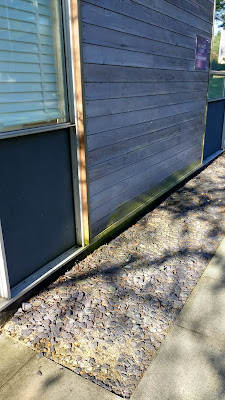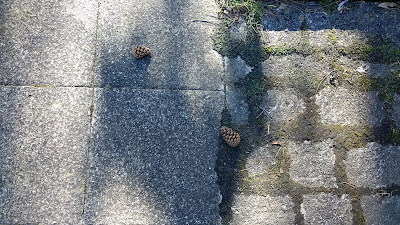My review of the exhibition Shaping Ceramics: From Lucie Rie to Edmund de Waal, which was shown at the Jewish Museum London earlier this year, is in The Journal of Modern Craft. I have a few complimentary copies. Let me know if you would like one.
28 April 2017
27 April 2017
THE MUSEUM OF APPLIED ARTS, BUDAPEST
Every time we go to Budapest we visit the Museum of Applied Arts (above), which always has one or two good temporary exhibitions. This April we went to see the collection of work by Marcel Breuer and his Hungarian colleagues. Breuer was of Hungarian origin – those who knew him well addressed him as Lajko, after his Hungarian birth name Lajos. Breuer is famous for his tubular steel chair, various versions of which (below) were produced (licenced and otherwise) in their millions.
 |
| Photo: Budapest Museum of Applied Arts |
The museum building is interesting in itself. It was designed by Ödön Lechner in Art Nouveau style and completed in 1896. Its sources are eclectic, with Hindu, Mogul and Islamic influences. The glazed roof tiles (below) were made by the Zsolnay pottery company, who were responsible for other Budapest monuments, including the roof tiles of the Matthias Church. In another blog post I wrote about the Schmidl family mausoleum in the Kozma Street Cemetery designed by Lechner and constructed by Zsolnay.
 |
| Photo: Wikipedia |
18 April 2017
OAKLANDS, ST ALBANS
I’ve complained about unimaginative and backward-looking domestic architecture in St Albans. Now, in the interest of balance, I show some pictures of an admirable contemporary housing development. It’s Oaklands, built on the site of the old St Albans college of further education and incorporating nearly all of the previous buildings. In a way it's retro - mid-century modern - because it modifies buildings designed in the late 1950s, but it's not sentimental or historicist.
7 April 2017
THE BEST HOMES AND FURNITURE, FOR THE MOST PEOPLE AT THE LEAST COST
I went to the Cotswolds yesterday to find out more about the Cotswold slipware potteries that I wrote about earlier. Before calling on Dinah Kunzemann, who used to run the Evenlode Pottery with her husband Dieter, I visited the Gordon Russell Design Museum in Broadway.
Russell was a first-rate furniture designer, a successful businessman, a humane influence on industry and an influential figure in 20th century design politics. The Museum traces his life through his work, from the early part of the century to the 1980s. A phrase that recurs is his wish to “teach the machine manners”. He came from an Arts and Crafts background but he wanted to make practical, modern furniture and he combined hand and power tools in his factory. The pieces on display are wonderful examples of the cabinet maker's art.
 |
| Gordon Russell "Double Helix" sideboard, 1950s |
I suppose my first connection with Russell was in my 1950s childhood through our Utility furniture. Because of Utility's use of native timbers, there was a lot of oak in our cupboards and chests of drawers. I cut them down and made shelves from them when my parents disposed of them - they're still in use.
Russell’s approach was like that of Charles and Ray Eames, who tried to make the best things for the least cost for the most people. My visit to Broadway made me think about my recent post on British housing, much of which is imitative, expensive and bland, housing that is not making a 21st century contribution to design and planning. These failings seem to me to be connected with the way the housing market is rigged.
5 April 2017
ALCHEMY IN THE CERAMICS STUDIO
I'm testing new glazes. I make small samples, using just 30 gm of dry matter, to which I add about 5% of stains. In these quantities, the measurement of stains has to be accurate to a hundredth of a gram. I have these great little scales, the little oblong thing in the middle of the picture, probably more widely used for weighing heroin than glaze stain, but perfect for the job.
I put the glaze samples on t-shaped tiles, suitably labelled, like the one on the left of the picture. After the tiles come out of the kiln, the bases are snapped off and they're mounted on an A4 board. The best of the tests is made into a large batch of glaze.
I'm looking for a good yellow glaze to go inside tableware. The outside will be a matt grey, which is being tested at the same time.
This is the scientific side of ceramics, which I enjoy as much as the artistic side - but not more so. A colleague makes pottery only so that he can write reports about his glaze experiments. For me the experiment is only a means to an end.
Some potters can't be bothered with this approach. I talked to Gordon Baldwin about his student days under Dora Billington, who was good on ceramic chemistry and who developed a range of glazes for her class at the Central School of Arts and Crafts. Gordon admitted he wasn’t a good student. “I didn’t have the right personality for that diligent testing," he told me. "My idea was more like that of an alchemist, stir it together see what you’ve got and put a pinch more in it.” That approach worked well for him. Different potters, different personalities, different approaches.
Subscribe to:
Posts
(
Atom
)























